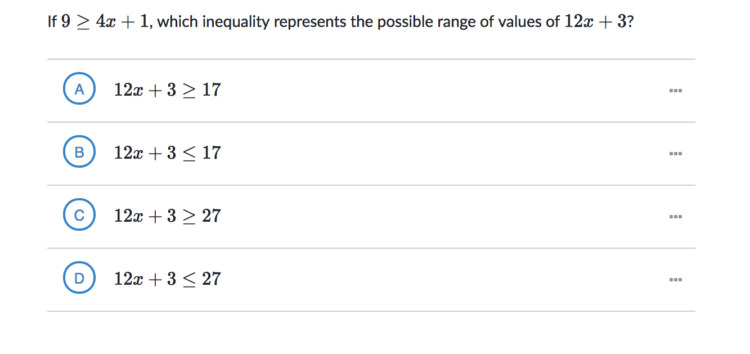What Does the Math Section of the SAT Test?

It’s not uncommon to get stressed before a big exam like the SAT. After all, this test can have a significant effect on your college prospects. While knowing what to expect from the test won’t entirely eliminate your fear, it should help you prepare for what’s to come.
The math sections of the SAT come third and fourth, after the Reading section and Writing and Language section. The first math section lasts 25 minutes and includes 20 questions that must be answered without the use of a calculator. For the second section, students have 55 minutes to answer 38 questions with a calculator. Both math sections feature multiple-choice and grid-in questions, in which students provide the answers. In most cases, the questions progress from easiest to hardest.
If you’re anxious about the math portion of the SAT, read on for more details on what these sections entail, along with tips on how you can perform your best.
Heart of Algebra
According to the College Board, approximately one third of the questions in the math section of the SAT fall into the Heart of Algebra. These questions involve a wide range of topics including linear equations, graphs, and systems. If you’re studying for this test section, brush up on your ability to:
- Interpret linear functions
- Solve and graph linear equations
- Solve systems of linear equations
- Solve linear equation and linear inequality system word problems
- Simplify expressions and equations
Students may be required to solve problems using multiple steps. The objective is often to solve for a variable within functions or show how a graph would be altered by a change in equation. Additionally, test-takers should be familiar with the most common mathematical formulas so they can call upon them quickly when needed.
Check out this sample Heart of Algebra question below:
Passport to Advanced Math
Called Passport to Advanced Math, the next group of questions on the SAT concerns more complex mathematics. Comprising around 28% of the exam, these questions may have students deal with quadratic equations and other polynomials. Additionally, Passport to Advanced Math topics can include nonlinear expressions, exponential expressions, radicals, functions, and more challenging word problems. To prepare for this part of the SAT, make sure you’re able to:
- Solve equations by factoring
- Divide polynomial expressions
- Match equations and their corresponding graphs
- Calculate the equations of curves
Having a solid understanding of formulas is crucial to achieving success on this portion of the SAT. Additionally, many students find that plugging possible answers into an equation is helpful in determining the solution to Passport to Advanced Math problems.
Here’s a sample question from the Passport to Advanced Math section of the test:
Problem Solving and Data Analysis
A little less than a third of the questions on the math section are classified as Problem Solving and Data Analysis. In this section, students will answer questions concerning topics like ratios and proportions, percentages, scatterplots, graph components, exponential growth, and data collection. To succeed on this portion of the SAT, prepare to do the following:
- Calculate ratios, percentages, density, and more for multi-step problems
- Match scatterplots with equations
- Summarize data using tables
- Evaluate mean, median, mode, and range using statistics
- Assess tables and graphs
- Convert between different units
Additionally, students should familiarize themselves with the properties of operations, which are parentheses, exponents, multiplication/division, and addition/subtraction. You can use the acronym PEMDAS to remember these properties.
Below is a sample question from the Problem Solving and Data Analysis section:
All sample questions come from the College Board website.
Other posts you may enjoy:
30 SAT Math Formulas You Need to Know
The Complete Guide to the 30-60-90 Triangle
Preparing for the SAT? Download our free guide with our top 8 tips for mastering the SAT.







